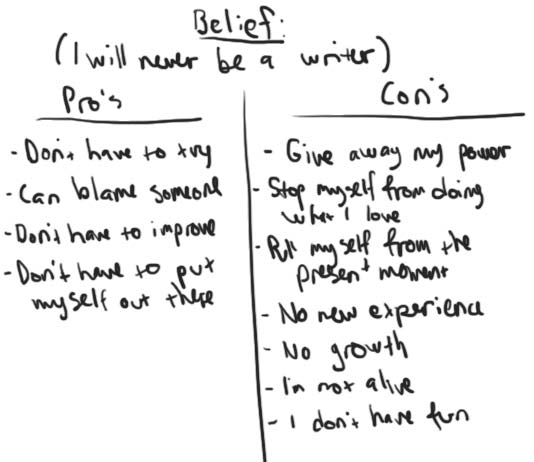Do you find yourself struggling to write?
Sometimes, negative thoughts make it difficult for us to write.
As writers, part of our job seems to be to struggle against ourselves.
But it doesn’t have to be so hard.
You can’t avoid the struggle, but it doesn’t have to paralyze you from doing the work you love.
You can fight these negative thoughts – and writer’s block – using a few proven techniques.
The key is to learn how your mind works.
Dr. David D. Burns, in his book Ten Days to Self Esteem, writes: “When you feel upset, the thoughts that make you feel bad are often illogical and distorted, even though these thoughts may seem as real as the skin on your hand. In other words, when you feel lousy, you are nearly always fooling yourself about something, even though you aren’t aware of this.”
Here are five patterns of distorted thinking that cause writer’s block, and how to fix them. The catch is that you have to write them down. The solutions will work only if you do the exercises with pen and paper.
#1. All-or-nothing thinking
All-or-nothing thinking is when you paint the world in black or white.
You may get a rejection letter and think, “I’ll never be a writer.”
You falsely believe that either you’re a writer, or you’re a hack. There is no in-between.
To beat all-or-nothing thinking, use counter-examples. A counter-example is an example that disproves your all-or-nothing statement.
We use them when we point out the flaws in a person’s statement.
Example
Angela finished her novel six months ago. The rejection letters have been piling up.
Today, she received another one. She feels defeated and wants to give up.
“I’m a loser,” she thinks.
To blast through her distorted all-or-nothing thinking, Angela starts writing counter-examples like:
– I’m the mother of two lovely children
– I exercise every day
– I show up and write, and I enjoy it
– I got an email from someone who loved a short story I wrote
By writing down examples of how she isn’t a loser, Angela feels better. Counter-examples help dissolve the absolute nature of all-or-nothing thoughts.
The next time you feel down in the dumps, identify the thought, and write at least five counter-examples.
#2. Emotional reasoning
When you feel sad, you tend to think sad thoughts.
Feel like a loser and you’re more likely to act like a loser.
But your feelings don’t make something true.
They don’t make you a loser; they merely make you feel like one.
In his book, Dr. Burns writes: “Your emotions result more from the way you view things than from what happens to you. That simple idea can help you change the way you think and feel.”
To deal with emotional reasoning, ask yourself: What would I have to believe in order to feel this way?
Then write the pros and cons of having that belief. This will reveal how the belief is helping you, and whether or not you want to keep it.
Example
Stephen feels frustrated with a story he’s working on.
He asks himself: What would I have to believe to feel this way?
The answer: I would have to believe that I will never be a writer. No one wants my writing, which means I should give up.
Stephen then grabs and pen and paper and makes a list of the pros and cons of having this belief.

Stephen takes a deep breath and reviews his list. The negatives of this belief clearly outweigh the positives, so he’s better off not believing this.
He doesn’t feel so bad anymore. The feeling is still there, but it’s less strong.
#3. Shoulds / Have-to’s / Musts
Any should, have-to, or must will bring up resistance to moving forward.
You may want to do the task, but deep down, you may be disconnected from the why.
The solution is to reconnect to why you’re doing what you’re doing.
What are you trying to accomplish?
Example
Danielle is surfing the web, thinking, “I should be writing. I have to write if I’m going to amount to anything.”
She writes:
What am I trying to accomplish by writing? I want to write because I love writing. Somewhere along the way I’ve lost that joy. I think it’s because I put too much pressure on myself to write like Hemingway.
Why do I love writing? Because it feels right. It’s hard to explain. I love the challenge of it. And it makes my heart sing.
Why do I love the challenge? I don’t know. It feels like something I was put on this planet to do. I love it. Even writing this, I’m already feeling lighter. I’m getting in touch with the feeling I used to have.
When you do this exercise, keep writing. Keep digging deeper to find your why.
#4. Dwelling on the negative
When you dwell on the negative, you zoom in on what’s wrong.
You forget about what’s going right in your life.
To get out of a negative funk, explore worst-case scenarios until you run out of steam.
This will help you let out the nervous, fearful energy that makes you focus incessantly on what could go wrong.
Example
Charlie is stuck with a story. And he’s blowing it out of proportion.
He decides to write down all his thoughts:
I’m a loser. I can’t write. If I were a good writer, I’d be able to come up with stories.
What’s the worst that could happen?
I’d end up on the street if I don’t write today. Really? No, I wouldn’t.
I’m being dramatic because I think that if I feel dejected, someone is going to come to my aid – just like my parents did when I was a child.
I notice that I don’t feel as bad about my writing.
So what if I’m stuck? Most writers spend some time on plateaus. What’s wrong with that?
I’m doing my best, and that’s enough.
Undoubtedly, you will write more than this. The important thing is to keep writing and get everything out on paper.
You may eventually start writing positive ideas, or you may not. It doesn’t matter, as long as you get all that anxious energy out.
#5. Letting life overwhelm you
Have you noticed that problems outside writing can stop you from writing?
The more worried I am, the less I can write.
Put another way: the more I think about my problems, the less space I have to focus on writing.
The solution isn’t to solve your problems, but to write them down, and brainstorm.
Getting them down on paper gets them out of your mind, which will calm you.
Example
Joshua’s been arguing with his wife because they’re tight on money. He feels the pressure to write something great.
He feels like he’s going insane with all the thoughts swirling in his head, so he grabs a pen and paper, and writes:
I need to make more money. But how?
What can I do right now?
I could write out those emails I’ve been meaning to send. I could ask Bruce to give me the promised introduction to that editor. I’ll put these on my to-do list and do them first thing tomorrow.
What about Betty?
We fought about money, and about my not being there for her.
She’s right. I need to spend more time with her and the kids. I spend too much time working. I’m trying to make money, but nothing’s happening.
I need to take a break, give myself time to recharge. And I need to establish priorities.
This exercise is about exploring your problems and brainstorming solutions. As you write things down, your problems loosen their hold on your mind because you can see them on paper.
This is not a quick fix, but something you do consistently to explore what you action you can take right here, right now.
Our thoughts play tricks with us, but we can fight back.
To do this, you have to be willing to uncover the truth (with pen and paper). You have to be willing to unravel what stops you from putting words on paper.
These exercises can be used interchangeably, so feel free to mix and match. Use what feels right.
But above all, do them.
Pick one problem right now, and use one of the exercises to nix it. You owe it to yourself.
What do you do to break through writer’s block? Share your tips in the comments!
















